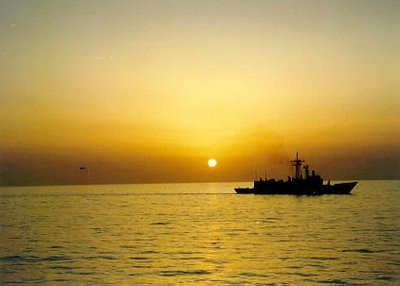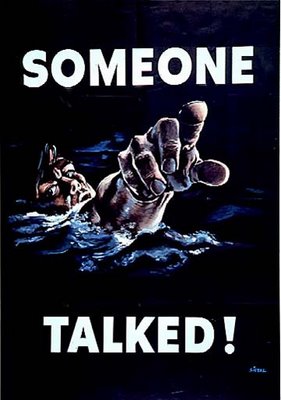This Weeks Photo:

(Persian Gulf - early 1995. Photo by Fred)
This weeks items:
River of Fireflies writes in "i am! a man! of the sea!" about his search to find out how to get a job on a merchant ship.
The Yankee Sailor fills us in on "USS McCampbell Collides With Tanker in Gulf" (NOTE: Warships normally travel twice as fast and are constantly changing course.)
The Jawa Report comments on Iran's test of a Torpedo that travels faster than 200 miles/hour.
American Crusader comments about the ACLU filing a discrimination suit against the Coast Guard because it required a Muslim to remove his (religious) head cap for his license photo, which he refused. The Coast Guard has recently issued the license but the ACLU is going to sue anyway. Read the inaccurate ACLU press release here. (NOTE: Muslim Countries REQUIRE the removal of head coverings for photos, especially drivers licenses.)
Moon of Alabama in his post "TEU Monsters" has coverage and pictures of the COSCO GUANGZHOU, currently described as the world's 'biggest' container vessel.
The California Office has a post about "California's Offshore Oil Drilling Issues." I have heard a number of stories from friends working on the West (left) Coast on tankers about how idiotic California is in treating oil tankers and oil shipments in general.
An Anonymous contributor sent in the story of yet another hijacking off of Somalia. Eaglespeak has further info as well as a post pointing to the latest ONI (Office of Naval Intelligence) Worldwide Threats to Shipping Report. I get the report via email every week and it always contains a surprising amount of activity. Each report normally ends with a summary of what Greenpeace activists have been up to in the ports. (29 March report here.)
Secular Blasphemy reminds us of the anniversary of the Falklands War.
The International Labour Organization (ILO) has a Database on reported incidents of abandonment of seafarers here.
Cannoneer #4 submitted a number of items including the following:
A story in Spiegel about a research trip that managed to record record-breaking 'Monster waves' which they point out should not be confused with freak waves.
The US Navy intends to donate the Battleship USS WISCONSIN to the city of Norfolk, VA. I suspect that this donation will go better than the Navy's attempt to donate the USS IOWA to San Francisco. Gay Patriot has coverage of San Francisco's refusal to be host so such a historic vessel. One vessel that has managed to find a home in San Francisco is the SS JEREMIAH O'BRIAN. See a photo essay of that vessel here.
Cargo shippers have finally added their two cents about all of the proposed security legislation and how it will disrupt the flow of cargo. (Scanning each container will add about $125/container.) See my post here listing many of the bills submitted in both halves of Congress.
The Times UK has story covering the concerns of global businessmen in the wake of the failed DP World port deal.
Surprising to me, US Shipyards are full, and will be for at least in the near future.
Also surprising to me, is the fact that a Senator from the desert State of Nevada can put a hold on the promotion of a Coast Guard Admiral. Thankfully, Senator John Ensign will drop his opposition to the promotion of a Coast Guard vice admiral who headed Hurricane Katrina recovery efforts. Apparently the Senator might have had a problem with how the Coast Guard did not rescue pets.
Newsweek plans to intdroduce Containerization to it's readers in their 10-17 April issue.
Finally, I predicted the demise of a UN Convention concerning Seafarer Identification due to fallout over the DP World Dubai Port Deal.
Other Items:
Take a look at a map charting the recent positions of the vessels operated by Oldendorff Carriers. Click on a vessel to see the name and ccordinates.
Take a look at the view from the GRAND PRINCESS shipcam. From there you can select other Princess vessel shipcams.
Weekly Maritime Reference:
This week we visit Container terminology:
There are five common standard lengths, 20 ft (6.1 m), 40 ft (12.2 m), 45 ft (13.7 m), 48 ft (14.6 m) and 53 ft (16.2 m). US domestic standard containers are generally 48 ft and 53 ft. Container capacity (of ships, ports, etc) is measured in twenty-foot equivalent units (TEU, or sometimes teu). A twenty-foot equivalent unit is a measure of containerized cargo capacity equal to one standard 20 ft (length) × 8 ft (width) × 8.5 ft (height) container. In metric units this is 6.10 m (length) × 2.44 m (width) × 2.59 m (height), or approximately 39 m3. These sell at about $2500 in China, the biggest manufacturer. [[1]]. Most containers today are of the 40-ft variety and thus are 2 TEU. 45 ft containers are also designated 2 TEU. Two TEU are referred to as one forty-foot equivalent unit (FEU). These two terms of measurement are used interchangeably. "High cube" containers have a height of 9.5 ft (2.9 m), while half-height containers, used for heavy loads, have a height of 4.25 ft (1.3 m). When converting containers to TEUs, the height of the containers typically is not considered. - Wikipedia
Previous Edition:
Maritime Monday #2 - March 2006
Maritime Monday Carnival #1 - 20 March 2006
Submission Guidelines:
Look here for more details: Submission Guidelines
Sponsors:
No sponsors for this week. You can sponsor this week's post retroactively. Then again, if you are interested in doing that, then you might consider sponsoring an upcoming post. Check the submission guidelines for more details.
Feedback Welcomed!

No comments:
Post a Comment